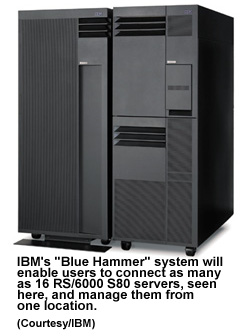|
IBM makes server play
|
 |
September 11, 2000: 12:07 a.m. ET
Big Blue moves supercomputing technology to high-end Web servers
By Staff Writer Richard Richtmyer
|
NEW YORK (CNNfn) - Hoping to strengthen its foothold in the fast-growing market for computers that power the Internet, IBM has adapted some of the technology used in its supercomputer systems to increase the reliability and streamline the management of its high-end Unix servers.
Big Blue is expected to announce on Monday the availability of a new product, called "Blue Hammer," which uses the same software that powers its supercomputers.
By transferring that technology to its high-end Unix servers, executives at IBM said they can reduce the cost of managing Web-based commercial computer systems, while at the same time increasing their reliability.
"We see this as coupling the best of the supercomputing systems, from a systems-management perspective, with the world's best server," said Deepak Advani, director of Unix strategy at IBM. "We're going to provide our customers a value proposition that they've never had."
IBM's supercomputing systems are made up of building blocks, called nodes, which are linked using software called Parallel System Support Programs, or PSSP. Each node is made up of an RS/6000 SP server with one or more microprocessors and its own memory and disk storage.
PSSP is used as the control center for IBM's supercomputers. It enables an operator to monitor and maintain the entire clustered system from a single point.
With Blue Hammer, IBM (IBM: Research, Estimates) is transferring that technology to its commercial Unix servers. It is targeting the new product at companies with mission-critical Unix systems in place, or the so-called "high-availability" market. These are typically companies engaged in e-commerce or other electronic services that need their Web sites up and running all the time.
 At first, Blue Hammer will be available on its high-end RS/6000 S80 Unix systems and enable clusters of up to 16 nodes. IBM also plans to expand the cluster solution to include its midrange Unix servers -- the M80 and H80 -- by the end of the first quarter in 2001. At first, Blue Hammer will be available on its high-end RS/6000 S80 Unix systems and enable clusters of up to 16 nodes. IBM also plans to expand the cluster solution to include its midrange Unix servers -- the M80 and H80 -- by the end of the first quarter in 2001.
"This technology not only helps to lower the cost of operation, but it also allows you to make changes to the architecture in a rolling upgrade fashion without having to bring the system down, so you can still have that high level of availability," said Brad Day, senior analyst at Giga Information Group.
The Blue Hammer product is the latest initiative in IBM's aggressive push in the Unix server market. Overall, Sun Microsystems (SUNW: Research, Estimates) is the leader in that market, followed by Hewlett-Packard (HWP: Research, Estimates), and then IBM.
However, in the high-availability market -- where vendors supply software and services in addition to the server hardware and guarantee a specified amount of system up-time -- IBM is running neck-in-neck with HP, according to Day.
"Those two have the lion's share of the high-availability cluster computing market, probably about 70 percent," he said.
For its part, HP is expected this week to unveil its latest high-availability server initiative, which will be built around a new machine dubbed "SuperDome." An HP spokesman would offer no further details about the Superdome system introduction.
"We are very excited about this," the spokesman said. "At the core of this announcement is the SuperDome server, but it's not just about the box. It's about having an integrated solution."
Like IBM, HP has been aggressively seeking to expand its share of the Web server market. However, when it reported its fiscal third-quarter earnings in mid-August, HP said its high-end server sales had grown only modestly. Executives attributed the slump to customers waiting for the introduction of the SuperDome system.
 Meanwhile, IBM has been making steady gains in the Web server market with its RS/6000 line. When the company posted its second-quarter earnings results in July, it said server sales had risen 30 percent from the previous quarter. Meanwhile, IBM has been making steady gains in the Web server market with its RS/6000 line. When the company posted its second-quarter earnings results in July, it said server sales had risen 30 percent from the previous quarter.
Part of the reason for that is the semiconductor technology IBM uses in the processors that power them, according to Giga's Day.
The transistors in the server processors are connected using copper wiring, which conducts electricity more efficiently than aluminum, the material that is used in most other computer chips. That means they can be built using much thinner wires, and each one can hold more transistors, allowing them to pack more processing power into a smaller package.
IBM transferred the copper chip technology from the high-end to its midrange Unix servers in May, and the RS/6000 popularity has been accelerating in recent months, Day said.
As part of its service, Giga Information Group advises clients on vendor selection. IBM has increasingly been among the firms' top picks, according to Day.
"Eighteen months ago, seven times out of 10, the short list for these large Unix environments was typically between HP and Sun," Day said. "In the last six months, that has dramatically shifted to putting IBM much more frequently on that short list."
"That capability from IBM really came about because they were able to build an architecture that had a much lower processor requirement with very extreme levels of performance," Day added. "That gave them a tremendous price-to-performance advantage in that market versus their traditional competitors, HP and Sun."
Since they were first rolled out in 1990, IBM says it has shipped more than 1 million RS/6000 systems. 
|
|
|
|
|
 |

|

